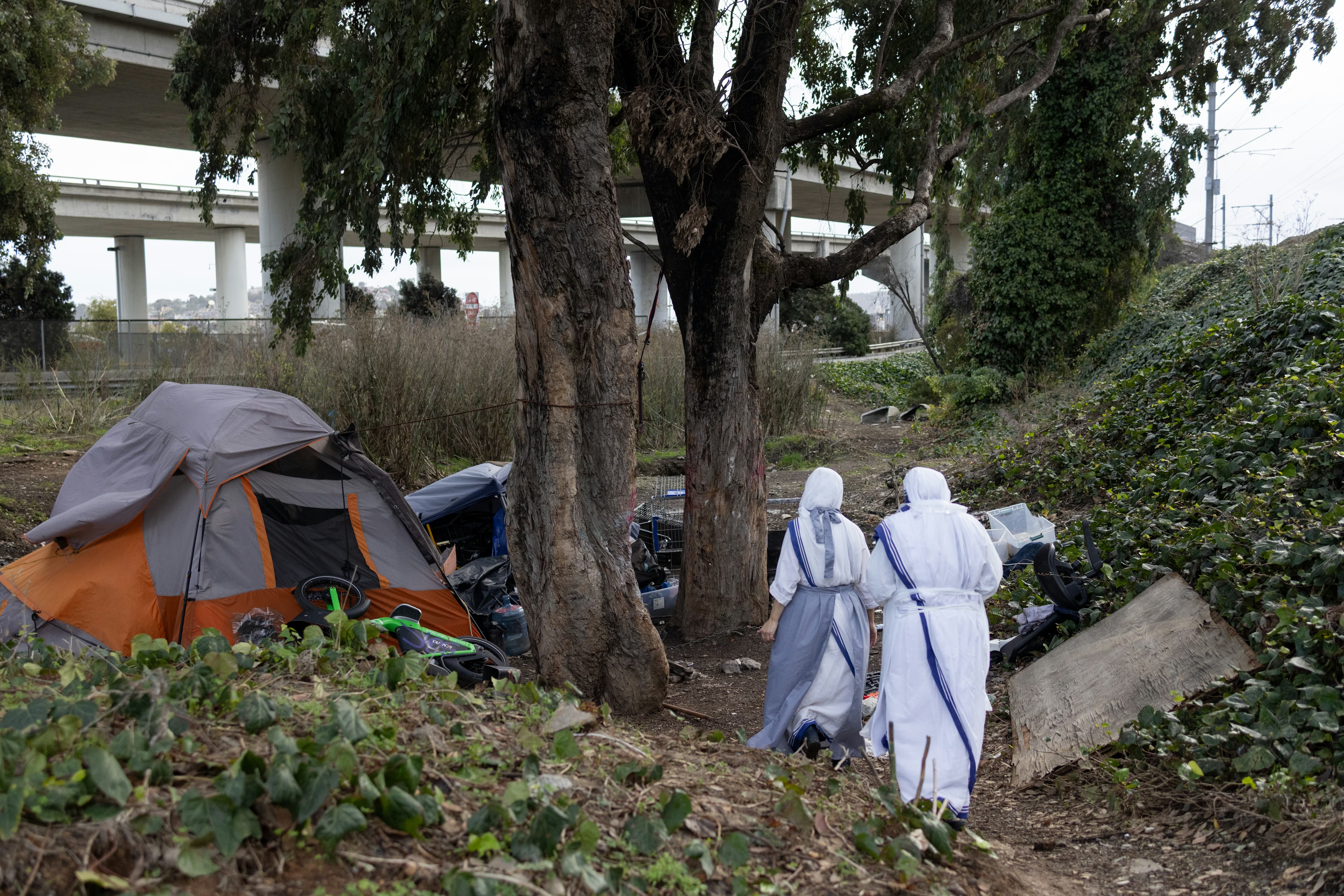Photographs by Rachel Bujalski
The blanket was filthy, and it was writhing—as if the person beneath it was trying to escape, or tear it apart.
As I watched from a van just up the road, at the intersection of 17th and Vermont, in San Francisco, Sister Salvina, wearing the blue-and-white sari of Mother Teresa’s order, explained how best to approach the person under the blanket. We would bring a tremendous offering of food: two water bottles, two juices, two Egg McMuffins, one meat-and-cheese sandwich, four Uncrustables, one cup of oatmeal, one hot chocolate, one banana. She recommended I keep my tape recorder in my bag, and handed me the banana.
The woman under the blanket was named Ashley. At the sound of Salvina’s voice, she pulled the blanket back so that it revealed her face but remained draped over her head like a hood. Her face was puffy and red, her eyes swollen into narrow slits—the aftermath of a pepper-spray attack, she said. (A number of homeless people have been assaulted with pepper spray in recent years.) “Would you like me to call the police?” Salvina asked. “No,” Ashley replied, in a soft voice.
No is Ashley’s mantra. When doctors ask to examine her, the answer is No. When paramedics offer treatment, the answer is No. When they try to hold her against her will, she runs. In the seven years Salvina has known her, Ashley has never willingly accepted psychiatric treatment. She has endured injuries and infections that have left her unable to stand—all under her blanket. If she keeps living this way, she’s going to die, and no one—not the city’s social workers, paramedics, or police officers; not even Sister Salvina—seems able to do anything about it.
In San Francisco, I met a man living in a nest of tarps and twigs, swatting invisible attackers from his face; a group huddled in an abandoned apartment, filled with guns and rotting food; and a man who sleeps not under the freeway but inside of it—in a hole he’d cut into the road’s undergirding.
For the past 50 years, the city has tried to hide from this problem in much the same way Ashley hides from her own. The general consensus in America has long been that people, regardless of how ill they are, should be given the greatest possible degree of autonomy. Now many political leaders—including the governor of California and the mayor of San Francisco—are acknowledging that Californians are dying in the streets from the freedom they’ve been afforded.
Those politicians are turning to what seems to be the only option left: forcing those who can’t take care of themselves into long-term involuntary treatment through a legal mechanism called conservatorship. In July, President Donald Trump issued an executive order calling for “shifting homeless individuals into long-term institutional settings” to restore public order. A few weeks later, the mayor of New York City announced his intention to force more drug users off the streets without consent.
California—home to nearly a quarter of the nation’s homeless population—has had a head start. In 2023, the state passed S.B. 43, a law meant to expand involuntary treatment to include people whose addictions put their lives at risk. The California ACLU objected to the law, and has called conservatorship “the most extreme deprivation of civil liberties, aside from the death penalty.” Alex V. Barnard, an NYU sociologist and an expert on involuntary treatment, called the law “a risky experiment taken in a desperate moment.” Yet on January 1, 2024, San Francisco became one of the first two counties to implement it. This January, the law will go into effect statewide.

Candidates for conservatorship—those with severe mental illness, addiction, or both—have an outsize influence on what the city feels like. In August, San Francisco Mayor Daniel Lurie told me about trying to walk his young children to school around a naked man who was “yelling and visibly ill”; most everyone who lives there has a similar story. But these individuals make up less than an estimated 5 percent of San Francisco’s homeless population. About half of people who are technically homeless have somewhere to sleep at night, and most aren’t dealing with the type of mental illness that might require long-term institutionalization. City politics over the past five years have focused on questions such as whether to provide drug users with clean needles, whether to give people housing before or after they get clean, when and how to administer methadone or other medications that can help wean users off heroin and fentanyl. But these debates largely exclude the issues of the most vulnerable individuals.
There is a man, a giant of a man, who sits all day at the bus stop at Oakdale and Bayshore (Look up the intersection on Google Maps, and there he is). He says only two words: regali and grazie. He rarely changes his clothes and, in the year Salvina has known him, has hardly ever left his seat at the bus stop. One day this spring, she found him lying on the sidewalk. Salvina called 911. As the ambulance arrived, the man got to his knees, then back onto his seat, where he wordlessly refused treatment. Salvina wanted the EMTs to hospitalize him anyway, but he didn’t meet the criteria for involuntary care. One said, “Well, we can’t kidnap him.”
Before 1972, that sort of involuntary commitment would have been easy enough. But for the past half century, involuntary treatment in California has been governed by the Lanterman-Petris-Short Act, one of the foundational texts of a national deinstitutionalization movement that contributed to the closure of asylums—including many where people endured horrific abuse—and the release of many mentally ill people onto the streets of cities that weren’t equipped to care for them.
[Jonathan Rosen: American madness]
The law created what Barnard calls a “conservatorship continuum”—a ladder of increasing restrictions aimed at ending indefinite involuntary institutionalization. On one side of the continuum is a 72-hour hold called a 5150. On the other are the conservators, who, for a year at a time, are given legal and medical decision-making power over people whom a judge has agreed are “gravely disabled”—unable to provide for their own food, clothing, or shelter.
This new system created a new problem. Three days in a hospital with the appropriate medication is enough time for most people to stabilize. Successful involuntary treatment, in other words, tends to make it impossible to continue involuntary treatment. But, once released, few stay stable for long.
Susan Eggman, who served as a California state senator from 2020 to 2024, witnessed the consequences. In 1975, somewhere in the Bay Area’s Castro Valley, her aunt Barbara began to believe she was the leader of a secret society that would one day birth a utopia free from hunger and poverty. Barbara disappeared, sometimes for days at a time, to wander San Francisco’s Tenderloin neighborhood, where she was repeatedly beaten, robbed, and raped. Barbara underwent about 50 short-term psychiatric hospitalizations without qualifying for long-term care.
For decades, that system continued, largely unchanged. One mother sent me a chart detailing her daughter’s medical care in the Bay Area over nine months in 2020: 21 different visits to medical and rehabilitation facilities, and seven 5150 holds.
When I spoke with Eggman in April, more than a year had passed since she had overseen the passage of S.B. 43. “It’s not bad to treat people,” she told me. “It’s bad to warehouse like we were doing. There has to be someplace in between.”
And yet most of California was in no rush to take advantage of the new rules before the deadline at the end of this year. When the law went into effect, only two counties—San Francisco and San Luis Obispo—implemented it. Governor Gavin Newsom sent a letter scolding the others for their inaction. The law gave counties “unprecedented tools” to help the “most vulnerable,” he wrote. “The months continue to tick by, but the majority of your jurisdictions have not met this moment of crisis with action.”

For advocates of expanded conservatorship, the magic word is compassion. In New York City, Mayor Eric Adams’s proposal to force addicts into hospitals is called the “Compassionate Interventions Act.” Trump’s executive order on homelessness states, “Surrendering our cities and citizens to disorder and fear is neither compassionate to the homeless nor other citizens.” Mayor Lurie told me he didn’t believe that it was compassionate to let people kill themselves on the streets of his city; the journalist Sam Quinones, who has written movingly about the opioid epidemic, and believes in expanding involuntary treatment, told me the same.
Compassion appears twice on the walls of the San Francisco Fire Department Community Paramedicine office, where multicolored rows of Post-it notes—the remnants of some long ago team-building exercise—describe the medics’ reasons for coming to work. Next to the Post-its, a poster reads every dead body on Mt Everest was once a highly-motivated person, so maybe calm down. It is from this tiny office, where someone has kicked off a pair of SpongeBob slippers under their desk, that California is testing its expanded system of involuntary treatment.
Eddy Bird, folded into an office chair much too small for a man of his size, showed me the list that dictates his days and nights. Bird is a captain on EMS-6, a paramedic unit with the authority to bring people into the hospital for 5150 holds. The list is a sort of leaderboard of the city’s most addicted, most mentally ill, least cooperative people. It occurred to me that Bird might have the worst job in all of San Francisco, a city that has employed a full-time “poop patrol” whose sole task was cleaning human waste from the sidewalk.
The head of EMS-6, April Sloan, platinum-haired with tattoos snaking up her forearms, told me the story of a man they brought in for treatment who had been very clear about his intentions. He did not want to live anymore, and he had a plan, he told everyone, to walk into traffic. So when he left the hospital to lie down in the middle of the street, the medical staff treating him shouldn’t have been surprised.

Pedestrians saw him lying in the street and called 911. An ambulance was dispatched to pluck the man up, circle the block, and bring him back to the same emergency room he had just exited, from where, before long, he was discharged once again. This time, the 911 calls came from the hospital waiting room, which had a view of the street. The man was transferred to another hospital, which held him for a few days before the same pattern resumed, and the 911 calls started to come in again. When people talk about a “revolving door” problem, it’s rarely this literal.
EMS-6 began to follow the man. When he attempted to walk into the street, they simply stopped traffic—a tactic more suited to a row of ducklings than a suicidal person. This man, you’d think, is a perfect candidate for conservatorship. Sloan eventually got him into a facility outside of San Francisco, but in February he was back on Eddy’s list, and in the hospital three times over four days, threatening suicide. When I asked Sloan why he hadn’t been forced into long-term treatment, she said she had no idea.
When S.B. 43 passed, Sloan expected hospitals to refer more people for more conservatorships, but that isn’t happening. In fact, the number of conservatorships granted has hardly budged. Although the number of new conservatorships edged up in the first six months after the law’s implementation, it soon returned to pre–S.B. 43 levels. At a hearing in June, San Francisco Supervisor Matt Dorsey said that, over the past 16 months, the city had “trained 1,700 people for something that we have done 186 times.” Nearly two years after the adoption of the law, the number of people referred for conservatorship solely for severe substance-use disorder alone remains zero.
Part of the problem is that no one seems to be acting in accordance with the expanded definition of gravely disabled. Sloan thinks that psychiatrists are reluctant to treat severe substance-use disorder as a condition worthy of long-term involuntary care. She acknowledges the dilemma they face: Because fentanyl moves through the body with remarkable speed, an addict without severe mental illness will improve drastically within 24 hours of admittance. Doctors would have to tell a responsive, clear-eyed patient: You are gravely disabled.
In this way, the expansion of grave disability has widened existing rifts within the conservatorship system. The psychiatrists, addiction doctors, and public conservators who are devoted to their patients’ recovery are more hesitant to revoke civil liberties than people working on the streets such as Sloan, Bird, and Salvina, whose mandate is survival.
As Sloan put it to me, “If someone is “ completely addicted to a substance and making choices that might result in their death or serious injury, then yeah, I think they need to be conserved.”
The system also faces a set of more fundamental problems: a lack of beds in long-term locked facilities, and a shortage of deputy public conservators, who are tasked with coordinating the care of conservatees. As of July, San Francisco had about one conservator for every 60 conservatees. The city budgets for 18 conservators; five of the slots were vacant. Privately run facilities could function as a stopgap, but instead, they cherry-pick the least disruptive patients. So the psychiatrists, judges, and lawyers who administer the system are left with a choice: discharge people to the street, or move them deeper into a system that has no place for them.
As a result, San Francisco is still seeing the same loop of short-term hospitalizations, nearly identical to the one that Barbara, Susan Eggman’s aunt, experienced in the ’70s. “You are trying to do what you think is right, but the system is broken,” Sloan told me, “ They keep just coming back out.”
Fixing the city’s conservatorship system starts with beds—up to 135 of them, in locked facilities and residential treatment centers. Along with the beds, the city needs to hire more medical staff, fill its open conservator roles, and improve coordination at the state level to track conservatees’ health status—about which the city knows little. The price tag for expanding the facilities, according to a city report from January, is between $10 and $30 million in onetime costs, followed by up to $20 million annually. In May, Mayor Lurie began to meet those first costs—securing $27.6 million from the state for new beds, which includes an expansion of locked care at Zuckerberg San Francisco General Hospital.
A functioning conservatorship system is essential to test S.B. 43’s boldest claim—that severe addiction alone can cause grave disability. Psychiatrists and judges will expand conservatorship only if they are confident that the confinement they impose in the short term will yield a new freedom in the long term.

For now, instead of becoming wards of the state, people on San Francisco’s streets remain the wards of individuals such as Sloan, Bird, and Salvina. “The very first day I worked here, I remember picking up somebody who was drunk at 6 in the morning and covered in pee. I remember looking at them and going, Why are you my problem?” Sloan recalled. “I’ve been here for 25 years. Now I know why they’re my problem.”
For providing this service, EMS-6 finds itself the target of the city’s frustration with a broken system. Callers to 911 complain that the paramedics don’t remove people from the street often enough. Emergency departments complain that they bring in patients the hospitals have no place for. “ Some people look at it and are like, You spent six months to get somebody to take a medication. Was that really worthwhile? I don’t know,” Bird told me, “It’s just a job I was tasked with, and we’ll continue to do it as long as we can.”
In the final hours I spent with EMS-6, Bird got a call to a social-work office at Mission and 9th. He let me accompany him. There was a man on the top floor who was known for getting violent when upset. He was upset. Four police officers joined us outside, put on black gloves, and waited for the man to be brought down. When he appeared, he walked calmly over to the gurney and sat down, saying simply, “I’m not losing my mind, I know where I’m at.”
“We want to make you as comfortable as possible,” a paramedic said as they strapped him down.
The post The Hardest Job in San Francisco appeared first on The Atlantic.




